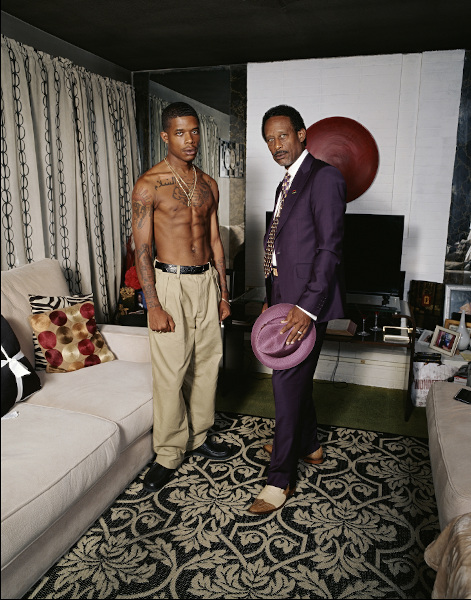Deana Lawson at the Guggenheim – The Black Lens Transformed

--Deana Lawson, Chief, 2019
“Art is the lie that enables us to see the truth.” The quote is by Pablo Picasso, but the photographer that personifies the philosophy is Deana Lawson. The 2020 winner of the prestigious Hugo Boss prize—the first photographer to be so honored—is turning perceptions of what it means to be Black on its head in her current show, “Centropy” at the Guggenheim Museum. But how does she do it? And how do we see it?
As the viewer moves from one gigantic pigment portrait to another, the eyes are drawn to her subjects as if by a gravitational pull. There’s nothing apologetic or submissive or even wary in these Black faces. In each domestic environment, they simply exist, in command of their surroundings. They don’t invite you in, but once you’re inside, there seems to be a mutual acceptance of your presence as a witness.
Make no mistake. Lawson is a conjurer—she has staged her moments, often with strangers, to startling effect. The rugs, curtains, carpets, religious icons, gold crowns, baby bottles and dollar bills are all, whether serendipitously found or improvised, props. The intimacy she creates, however, emerges as some version of the truth. It’s not surprising that visitors linger or come back, more than once or even twice, to see if what they see is real.
In a May 9th New York Times profile by Jenna Wortham, Lawson seems to justify her approach. “I’m giving an image that I do want you to believe; that is real—it is real, to me, in this moment, and I don’t want that to be minimized because the believability is important.”
In Monella Passing, a seated man slouches next to the corpse of a woman who is laid out, her fingers elegantly splayed out in her netted gloves, eyes shut. I was struck by the word “passing” in the title.This is a transitory moment, with Lawson’s subject suspended somewhere between life and death. In Latifah’s Wedding, the bride’s veil is showered with bills, her husband’s suitcoat similarly covered, while a wedding guest sits with her plate nearby, indifferent to this display. A little costumed girl stands proudly on her bed, her face obscured by strings of beads, a complicit grandmother at her side, in An Ode to Yemaja. It smacks of ritual, of secrecy, but the photographer offers no explanation.

--Deana Lawson, Young Grandmother, 2019
Perhaps the most intriguing portrayal of Black women is Axis, the three naked, entwined on a dark floral rug, their adornments, from heart tattoos to sequined nails on display. There is a classic beauty at play here, in opposition to their 19th century photographic counterparts, when images of Black females were synonymous with a libidinous and deviant underworld.
Not all portraiture on display is indicative of otherworldly realms or the overlay of cultures in the Black diaspora. Some are simply direct and riveting in their domestic reality as Barrington and Father. Two generations in stark relief pose triumphantly before us. The elder is a prototype of the urban gentleman, straw hat in hand, spats to match, a brown polka-dot tie to finish off the effect. His son conversely, is gold chained, bare chested, tattoos sporting among other signs, an Indian avatar. There’s no mystery here.
Yet the importance of ritual and the search for a deeper meaning in existence is a major component in Lawson’s oeuvre. Tucked into one corner of the exhibit are three selenite crystal wands, selenite symbolizing the protective properties of a healing goddess. In another corner, rose crystal tiles are interspersed with snapshots from the artist’s stable of friends and family.
In recent years, Lawson has admitted to creating environments for the work itself, in order to allow for the reflection “of both looking and being looked at” she desires from her audience. Her portraits are framed in mirrored glass, so that standing at a certain angle in front of a portrait one confronts the self. Where holograms in the portraiture are embedded, does it detract or enhance the overall effect? It’s hard to say.

--Deana Lawson, Barrington and Father, 2021
Traversing the clean rectangular space, another oval-shaped hologram is placed on a pedestal, reminiscent in feeling if not similarity to the monolith found by space travelers in Stanley Kubrick’s spectacle 2001. On closer inspection, two concave eyes seem to peer out from the interior. Another surprising instance, Dana and Sirius B is an image of a night sky, in which the eponymous star is nearly eclipsed by its sister, Sirius A, the brightest star in the firmament. (Dana is the name of Lawson’s twin sister.)
Born in Rochester, New York, in 1979, Lawson grew up sitting for family portraits. The Kodak empire was rooted in her hometown, with her mother finding administrative work there and her grandmother cleaning house for the founder George Eastman.The camera and its innate power to conjure images obviously worked its magic on her. And hers is an impressive, almost meteroric climb to prominence in the photographic universe. The name of the exhibit, “Centropy” refers to a thermodynamic term meaning a gathering or coalescing of energies into a natural order.
Such an ambitious search is not foreign to an artist of Lawson’s caliber. Sometimes with maturity comes a recognition of the power in simplicity itself. The most memorable takeaway in this exhibit is in the transformative power of her portraiture. There are subjects here that form their own supernovae and they give a lovely light.
Author Bio:
Sandra Bertrand is Highbrow Magazine’s chief art critic.
--All images: Copyright © Deana Lawson
(1) Deana Lawson, Chief, 2019
(2) Deana Lawson, Young Grandmother, 2019
(3) Deana Lawson, Barrington and Father, 2021
For Highbrow Magazine































































































































































































































































































































